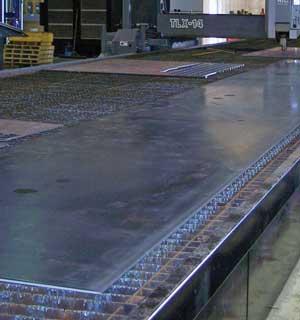- FMA
- The Fabricator
- FABTECH
- Canadian Metalworking
Lasers Go Large
Machines with large beds create the parts needed for heavy equipment, enable all-night cutting
- April 22, 2013
- Article
- Fabricating

Maintaining a consistent beam diameter throughout beam delivery results in stable cutting of various material thicknesses. Photo courtesy of NTC Laser.
With overseas manufacturers continuing to place pressure on domestic producers of high-volume, low-value work, Canadian companies need to continue to push the envelope in other areas. By literally pushing the envelope size of their laser cutting equipment, shops can serve the needs of local heavy equipment manufacturers, or use the large bed size to run multiple jobs in an unmanned third shift.
Canadian Industrial Machinery (CIM) asked industry experts Jeff Hahn, laser product manager for MC Machinery Systems/Mitsubishi Laser, and Steve Glovak, national sales manager for NTC Laser, to talk about this market segment. Here is what they had to say.
CIM: When should a shop consider adding a large laser cutter to its floor?
Hahn: Any manufacturer that wants to reduce the cost per part, get more parts per sheet, and create larger-scale parts without needing welding and all of the labor and fixturing costs associated with that should closely examine the size of its laser bed as it relates to the manufacturing process. Sometimes size does matter.
CIM: Do such systems typically produce large parts, multiple parts on larger sheets, or both?
Hahn: I think that shops that have this capability will not only want to do both, but do them both at the same time. If the system also has a pallet changer, it becomes even easier to do different kinds of jobs without stopping to unload the machine.
Being able to produce a large part, like a boom for a crane, without the need for welding is a major money-saver. Similarly, being able to get more parts out of a single sheet lowers the cost per part.
An added benefit is that manufacturers also can get a cheaper price per sheet of steel from the mill when they order it in larger sizes.
CIM: Can multiple parts be produced from multiple materials without the need for operator intervention?
Glovak: Yes. Changing the cutting conditions for specific parts or materials, and then incorporating those cutting conditions into the part program, is not an issue. After the cutting conditions are optimized, most programming problems are eliminated.
CIM: Is this best done through off-line programming?
Glovak: Yes. While this depends on the individual shop environment, offline programming is generally more efficient.
Hahn: Thoughtful preplanning during programming and job scheduling will always reduce the number of headaches during production. Thinking a problem through first will eliminate lost time at the machine.
For example, if you are cutting multiple parts on different materials and have an optional nozzle changer, you can purge out the assist gas, change the nozzle, and keep cutting. With proper preplanning, you can create a program that will etch with air, pierce with oxygen, and cut with nitrogen without the need for an operator to be present.
CIM: Does the optics system change as the laser cutter's bed gets larger?
Glovak: The length of the bed has little effect on beam delivery through the optics system. It is important, however, to maintain a consistent beam diameter throughout beam delivery. This results in stable cutting of various material thicknesses. A collimator optics system typically is used to keep beam delivery consistent over the entire bed.
Hahn: Our large-bed laser cutting machines use a fixed-beam system. This means that no matter where you are on the table, the beam diameter is the same. A separate servo system on the bend mirrors moves as the cutting head moves, keeping the diameter of the beam constant. This is the methodology we've used on all of our laser systems since 2001. The head position is sent back to the control, which moves the servo system on the mirrors to ensure that the beam diameter is constant everywhere on the table.
CIM: What is the role of the chiller, and how is it integrated in these large systems?
Glovak: Just like with any other laser cutter, the chiller cools the hot laser gases generated inside the laser oscillator.
Hahn: Our newest large machine is the 6030XL, and both its resonator and chiller have fixed positions that are stationary off of the work center. This means that all you have to do is extend the gas hoses from the source to the cutting head. Nothing else needs to be changed.
CIM: How do you combat inertia and create the necessary positioning accuracy?
Glovak: Inertia is monitored and corrected by digitally controlled servomotors, encoders, and feedback circuitry. Positioning accuracy is controlled by the drive system, which in larger work envelopes usually is a rack-and-pinion system.
Hahn: We use the same bridge on our large machine that we do on our smaller eX machine. We already had that existing bridge technology, and that optical path has been proven for many years, so we didn't see a need to change it.
CIM: Is the loading/unloading of these machines a challenge?
Glovak: Not if it's done correctly. This is usually done with cranes because of the size and weight of the steel sheets.
subscribe now


Keep up to date with the latest news, events, and technology for all things metal from our pair of monthly magazines written specifically for Canadian manufacturers!
Start Your Free Subscription- Trending Articles
- Industry Events
MME Winnipeg
- April 30, 2024
- Winnipeg, ON Canada
CTMA Economic Uncertainty: Helping You Navigate Windsor Seminar
- April 30, 2024
- Windsor, ON Canada
CTMA Economic Uncertainty: Helping You Navigate Kitchener Seminar
- May 2, 2024
- Kitchener, ON Canada
Automate 2024
- May 6 - 9, 2024
- Chicago, IL
ANCA Open House
- May 7 - 8, 2024
- Wixom, MI














